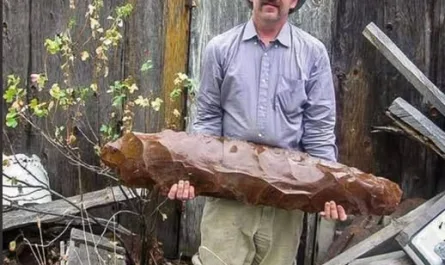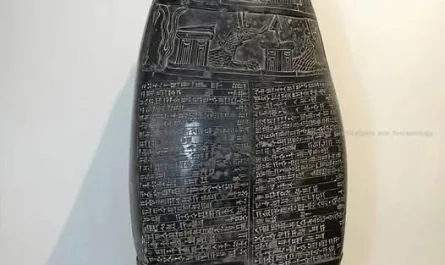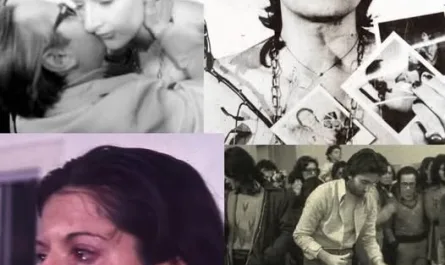The Riace Bronzes, also known as the Riace Warriors, are a pair of bronze statues most likely sculpted in Greece in the mid-5th century BCE and rescued from the Ionian Sea near Riace Marina, Italy in 1972 CE. Slightly larger than life-size, the nude male figures represent two warriors, one older than the other, and they are considered masterpieces of Classical Greek sculpture. Restored and protected from future corrosion, they stand magnificent in their own environmentally-controlled room within the National Archaeological Museum of Reggio Calabria in southern Italy.
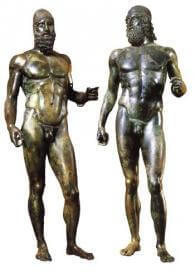
The two bronzes were miraculously discovered in the Ionian Sea off the coast of Riace Marina in southern Italy on 16 August 1972 CE. Mr. Stefano Mariottini, a novice scuba diver from Rome, made the discovery of the Bronzes of Riace while on vacation along the Calabrian coast.
They ended up being one of Italy’s most significant archeological discoveries in the previous 100 years. The two sculptures straddle reality and myth, appearing both human and divine.
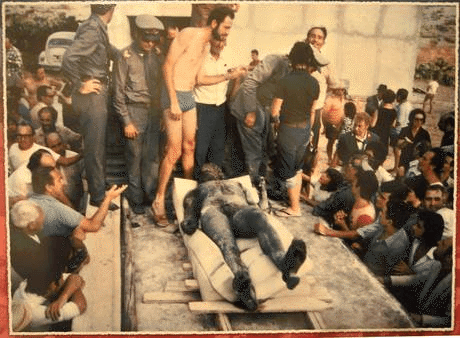
These well-known figures are shrouded in secrecy; we don’t know anything about their identity, paternity, or origins, let alone where they came from.
These art pieces are beautifully made and succeed in evoking strong emotions in the public. These are, in fact, the primary causes of the enthusiasm that the Riace bronzes have sparked.
However, some talk about “magnetic force,” “eroticism,” and “halo of fear.” Others introduce Freud into the conversation. We will talk about this topic in great detail later.
They were first displayed in Florence, followed by Rome, and finally, as well as lastly, in the Museum of Reggio Calabria.
The Romans, after conquering Greece, stole the great artistic patrimony and moved it through a low coastal navigation, along the safer open sea roots of the Ionian coast, which may explain why there are statues in the sea depths today.
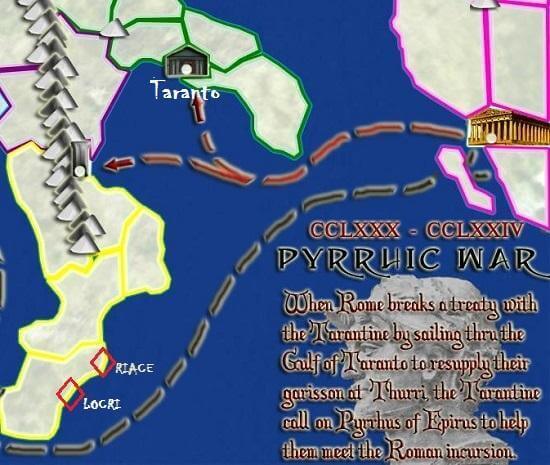
Even if the Bronzi belonged to a Great Greece town like Tarrant (Taranto-Apulia), a transportation towards Rome is objectionable. However, if we place the statues in Locri Epizephiri, it would be more difficult to comprehend why they were more than 30 km north and facing the wrong way. One theory is that the statues were removed during the theft of Locri by Pirrus, the Epirus’ king, in 275 B.C.
It is more likely that the statues were thrown overboard in order to lighten the load on the ship during a storm or to keep them out of pirates’ hands.
The statues depict two hunky men, possibly gods or warriors, who may have once wielded lances and shields.

They are considerably larger than life at about two meters. The ‘older’ man, identified as Riace B, is wearing a helmet, while the ‘younger’ Riace A is wearing nothing to cover his ruffled hair.
They are both naked. Although the statues are made of bronze, they have ivory, limestone, glass, and amber paste eyes, silver lashes and teeth, copper-red lips, and copper-colored nipples.
Italian archeological treasures are well-known, but the Riace bronzes have garnered particular interest.
This is due in part to their incredibly realistic rendering and in part to the rarity of old bronze statues, as the metal tended to be melted down and reused.
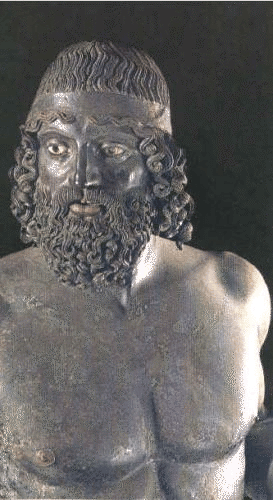
Mariottini said the bronze was so real that at first he believed he had discovered the remains of a corpse after discovering the statues 300 meters off the coast and eight meters underwater.
Millions of people visited them when they first went on display in 1981, and they were even the subject of a special postage stamp.
The statues draw about 130,000 visitors a year to the Reggio Calabria museum where they are on display. Since there were no wrecks in the area, it is unknown how or when the statues submerged to their watery resting place.
The two “champions” represented manliness in the collective public’s imagination, their “miraculous” reappearance from the waters having touched everyone’s subconscious.
While archeology is more abstract, let’s try to learn more about these two magnificent statues, which are among the few remaining authentic, antique bronze sculptures.
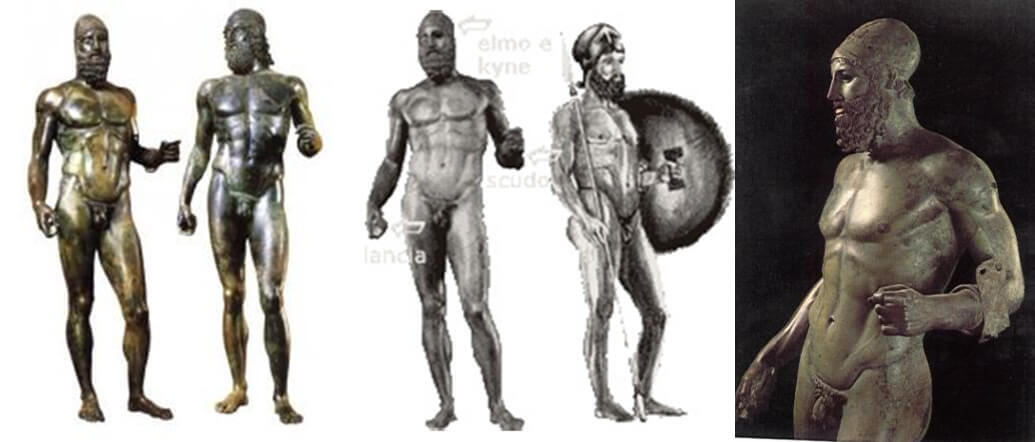
In both instances, the left arms still show signs of a former shield; traces in the hairstyles imply that each individual once wore a helmet.
Half-closed, the right hands were holding something that couldn’t yet be positively identified.
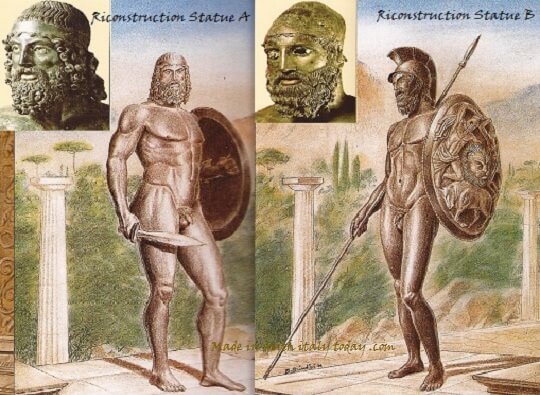
In the Bronze A, this movement does not affect the upper part of the thorax, where the pectorals and shoulders are almost horizontal, whereas in the Bronze B, it affects both the pectorals, defined by a tilted line, and on the shoulders: the right one is in a lower position than the other. As a result, the right thigh stands higher than the left one.
The two statues display a crossed rhythmic pattern in their bodies. The left arm, leaned to hold the heavy shield, corresponds with the upright right leg, which bears the weight of the body; the right arm, with the lower right arm holding the mast, corresponds with the flexed left leg, in a forward position.
In the Bronze A, the plastic vigor strengthens the strong muscles in a more geometrical and static way, whereas in the Bronze B, it does so in a more analytical and dynamic way.
The sub-skinned veins are one of the anatomically correct details that the Bronzi reproduces, and they are especially noticeable in the hands and feet.
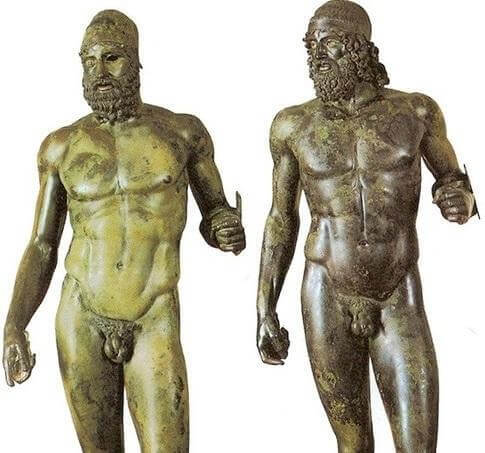
Even the separately manufactured, hammered-applied pinked colored nipples (not made from copper, but from a small amount of lead) are intriguing.
The ability to display the beauty of the human body while being naked is thought to be a crucial component of both “virtue” and one’s capacity for moral and intellectual development.
Due to the fact that athletes played naked and received hero’s honors in the event of victory, being naked was the ideal way to represent divinities, heroes, and also athletes.
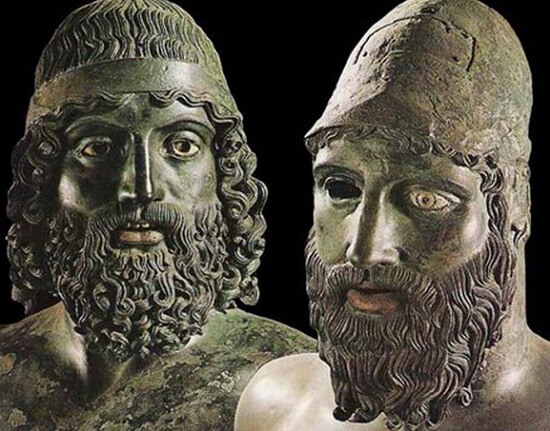
Head of the “A” statue. The hair on the head is held back by a wide band and has a finely defined shave with strongly plastic sinuous wisps.
The long wisp of waved hair that covers the entire scalp and falls into curled wisps on the shoulders leads us to believe that the head was originally helmetless; on top, there is a hollow that may be for a meniscus as well as a practical bronzed tip to deter birds from landing on the statues.
Nevertheless, a Corinthian helmet was positioned a second time, as indicated by standing signs, and the original hollow was changed into an inlet for the same helmet. At that time, applied wisps covered the nicely shaped ears.
The mouth has copper-colored lips and an upper row of five silver-foil-shaped teeth.
The eyes have ivory corneas and bronzed foiled lashes, while the iris, which was not preserved, was likely made of a precious stone or glassed pasta.
The bronze A would stand in for Tideus, who was so ferocious that he bit his foe and ate his brain (hence the silver teeth that could be seen);
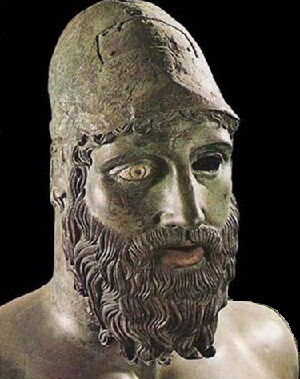
Head of the “B” statue. We can see some plate cats, covered by light hammering and the sulk on the sides of the shave the lower side of the throat; the head is smooth and deformed, likely as a result of the raised Corinthian helmet, and covered by a leather or felt cap.
Lower lobes of the ears and wisps of hair that resembled those from a recent shave but were plastic in nature emerged from the cap.
We only have the right eye, which has the white-marbled cornea, the iris, which is made up of a whitish ring and a pinkish one, and the black eye pupil. Even the mouth has the copper-colored lips.
Anfiarao, who predicted his own demise thanks to his prophetic spirit (remembered by the cap worn by seers), would be the Bronze B.
Other Elements Differentiate Them
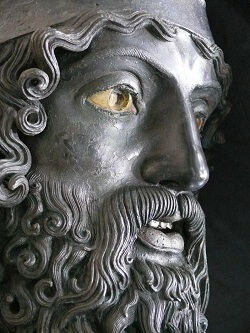
In addition to having a different face, hairstyle, and beard, statue B has a significantly displaced right hip, which places it in the generation immediately succeeding statue A.
The head, the thorax, the arms (divided into three sectors), the hands, the legs, the feet, and the medium-sized fingers on the feet have all been separately cast and then welded together to create the Bronzi.
According to a widely held belief, two sculptors from various historical eras created the Bronzi.
The theory that they were created in Attica, in the environment of Phydia, the creator of the sculptures that decorate the famous Parthenon of Athens, is confirmed.
The A statue was created around the middle of the 5th century B.C., while the B statue, with its new artistic sensibility and Polycletus as its primary creator, was created 30 years later.
Their shared stance, the similarity of the metal alloys used, the fusion process, and the skill demonstrated in the metal inlay used for specific touches (the areolas, lips, and teeth) all point us in the direction of their origins and original intent.
How else could we account for these traits continuing for about 30 years?
This is especially true given that these 30 years fall during the fifth century’s richest, most vibrant, and most innovative period. BC in the era of Phidias and the enormous Parthenon workshop, surrounded by a classical environment.
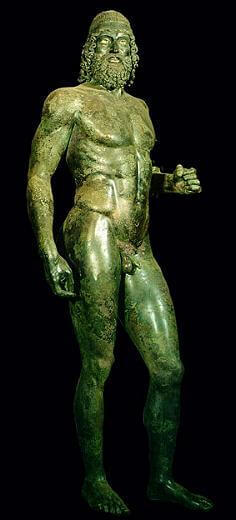
The two bronze statues were likely commemorative offerings, erected by the winners of the “oplitodromies” (races between athletes in heavy armour introduced in Athens in 520 BC and continued until Hellenistic times). Experts have not reached a final unanimous agreement on this, but it is very likely.
The fame that these race winners attained persisted for as long as their monuments.

